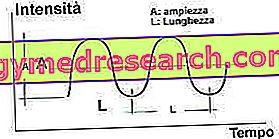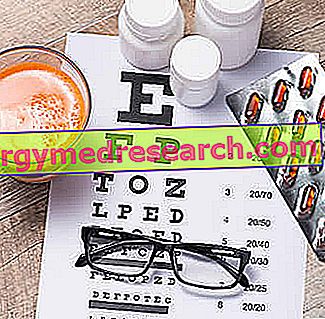Ultrasound is a diagnostic technique that uses ultrasounds. The latter can be used in the execution of a simple ultrasound, or combined with a CT scan to obtain images of body sections (Tc-Ecotomografia), or even to acquire information and images of the blood flow (Ecocolordoppler).
Deepening Articles
Operating principle Methods of execution Applications Preparation Ultrasound of the prostate Ultrasound of the thyroid Liver ultrasonography Abdominal ultrasonography Breast ultrasound Transvaginal ultrasoundMorphological ultrasonography in pregnancyPrinciple of operation
In physics, ultrasounds are mechanical longitudinal elastic waves characterized by small wavelengths and high frequencies. The waves have typical properties:
- They do not transport material
- They go around obstacles
- They combine their effects without changing each other.
Sound and light consist of waves.
The waves are characterized by an oscillatory motion in which the solicitation of an element is transmitted to the neighboring elements and from these to the others, until it propagates to the whole system. This motion, resulting from the coupling of individual motions, is a type of collective motion, due to the presence of elastic bonds between the components of the system. It gives rise to the propagation of a disturbance, without any transport of matter, in any direction within the system itself. This collective motion is called a wave. The propagation of ultrasound takes place in matter in the form of wave motion which generates alternating bands of compression and rarefaction of the molecules that make up the medium.
Just think of when a stone is thrown into a pond and the concept of wave is clear.
The wavelength is intended as a distance between two consecutive points in phase, that is, having the same amplitude and sense of motion at the same time. Its unit of measure is the meter, including its sub-multiples. The wavelength range used in ultrasound is between 1.5 and 0.1 nanometers (nm, ie one billionth of a meter).
Frequency is defined as the number of complete oscillations, or cycles, that the particles perform in the unit of time and is measured in Hertz (Hz). The range of frequencies used in ultrasound is between 1 and 10-20 Mega Hertz (MHz, or one million Hertz) and is sometimes even greater than 20MHz. These frequencies are not audible to the human ear.
The waves propagate with a certain speed, which depends on the elasticity and density of the medium they pass through. The speed of propagation of a wave is given by the product of its frequency by its wavelength (vel = freq x wavelength).

To propagate, the ultrasounds need a substrate (the human body for example), of which they temporarily alter the elastic cohesion forces of the particles. Depending on the substrate, therefore depending on its density and the cohesion forces of its molecules, there will be a different speed of propagation of the wave inside it.
Impedance Acoustics is defined as the intrinsic resistance of matter to be crossed by ultrasounds. It conditions their propagation velocity in the matter and is directly proportional to the density of the medium multiplied by the speed of propagation of the ultrasounds in the medium itself (IA = vel x density). The different tissues of the human body all have a different impedance, and this is the principle on which the ultrasound technique is based.
For example, air and water have low acoustic impedance, fat liver and muscle have it intermediate and bone and steel have it very high. Moreover, thanks to this property of the tissues, the ultrasound can sometimes see things that the CT (Computerized Tomography) does not see, such as for example hepatic steatosis, ie the accumulation of fat in hepatocytes (liver cells), hematomas from contusion (extravasation of blood) and other types of fluid or solid isolated collections.
In ultrasound ultrasounds are generated by high frequency piezoelectric effect . Piezoelectric effect means the property, possessed by some quartz crystals or some types of ceramics, of vibrating at high frequency if connected to an electric voltage, therefore if crossed by an alternating electric current. These crystals are contained within the ultrasound probe placed in contact with the skin or tissues of the subject, called a transducer, which thus emits ultrasound beams that pass through the bodies to be examined and which undergo an attenuation that is directly related to the transducer output frequency. Therefore, the higher the frequency of ultrasounds, the greater their penetration into the tissues, with a greater resolution of the images. For the study of abdominal organs work frequencies between 3 and 5 Mega Hertz are usually used, while higher frequencies, greater than 7.5 Mega Hertz, with greater resolutive capacity, are used for the evaluation of superficial tissues (thyroid, breast, scrotum, etc.).
The transition points between fabrics with different acoustic impedance are called interfaces . Whenever the ultrasounds encounter an interface, the beam is partly reflected (back) and partly refracted (ie absorbed by the underlying tissues). The reflected beam is also called echo; it returns to the transducer where it returns to energize the probe crystal generating an electric current. In other words, the piezoelectric effect transforms ultrasound into electrical signals which are then processed by a computer and transformed into an image on video in real time.
It is therefore possible, by analyzing the characteristics of the reflected ultrasonic wave, to obtain useful information to differentiate structures with different densities. The reflection energy is directly proportional to the variation in acoustic impedance between two surfaces. For significant variations, such as the passage between the air and the skin, the ultrasound beam can undergo total reflection; for this reason it is necessary to use gelatinous substances between probe and skin. They are intended to eliminate air.
Execution methods
Ultrasound can be performed in three different ways:
A-Mode (Amplitude Mode = amplitude modulations): it is currently exceeded by the B-Mode. With A-Mode, each echo is presented as a deflection of the baseline (which expresses the time needed for the reflected wave to return to the receiving system, ie the distance between the interface that caused the reflection and the probe), as a "peak" whose amplitude corresponds to the intensity of the signal that generated it. It is the simplest way to represent the ultrasound signal and is of the one- dimensional type (ie it offers an analysis in a single dimension). It gives information on the nature of the structure in question (liquid or solid). A-Mode is still used, but only in ophthalmology and in neurology.
TM-Mode (Time Motion Mode): in it, the A-Mode data is enriched by the dynamic data. A two-dimensional image is obtained in which each echo is represented by a luminous point. The points move horizontally in relation to the movements of the structures. If the interfaces are still, the luminous points will remain still. it is similar to A-Mode, but with the difference that echo movement is also recorded. This method is still used in cardiology, especially for demonstrations of valve kinetics.
B-Mode (Brightness Mode): it is a classic Ecotomographic image (ie of a section of the body) of the representation on a television monitor of the echoes coming from the structures under examination. The image is constructed by converting the reflected waves into signals whose brightness (shades of gray) is proportional to the intensity of the echo; the spatial relationships between the various echoes "build" on the screen the image of the section of the organ under examination. It also offers two-dimensional images.
The introduction of the gray scale (different shades of gray to represent echoes of different amplitude) has improved the quality of the ultrasound image. Thus all body structures are represented in tones ranging from black to white. The white dots signify the presence of an image called hyperechoic (for example a calculation), while the black points of a hypoechoic image (for example liquids).
According to the scanning technique, the B-Mode ultrasound can be static (or manual) or dynamic (real-time). With real-time ultrasound scanners, the image is constantly reconstructed (at least 16 complete scans per second) in the dynamic phase, providing a continuous representation in real time.
CONTINUE: Ultrasound applications »



